-
Article
tells about the tradition of Cheriyal Painting tradition, process, challenges
and artists are re-inventing the tradition.
Scroll
paintings have a rich history and play an important role in the Asian artistic
tradition. In China, scroll paintings were part of the sophisticated traditions
of the nobility and the courts. In India however, the scroll painting was the
prerogative of the itinerant bard and the village artist, in essence a folk
tradition of the villages.
In
India, each region and village developed its own scroll painting traditions,
marked by characteristic content, form and technique depending on the local
ethos, patronage and socio-economic conditions.
Rajasthan
is known for its Pabuji ki Pad, Devenarayana katha as also stories
from the legend of Dhola and Maru. Goa evolved the Dasavathara, as Maharashtra
did Pinguli and the Chitra Katha traditions. Maharashtra
and Gujarat are also known for a sophisticated scroll painting tradition called
the Prasasti Patra. Orissa and
Bengal are famous for their Pattachitra traditions.
While
the above-mentioned traditions could have significantly influenced the Cheriyal
scroll paintings and artists, the Cheriyal paintings were and
continue to be a distinctly local invention, peculiar to
the Telangana region, drawing mainly on local traditions. It can
safely be said that the local temple art traditions and the Kalamkari tradition
across Telangana in particular, and the graphic art traditions of the
Deccan and South India in general were the major influences that shaped and
guided the art of scroll paintings.
However,
it should also be remembered that the sphere of activity, subject and artistic
idiom of every scroll painting including that of Cheriyal is peculiar and
confined to the village.
Cheriyal Scroll Paintings
Cheriyal
Scroll Painting is a stylized version of Nakashi art, rich in the
local motifs peculiar to Telangana.
They
are at present made only in Hyderabad, Telangana, India. The scrolls are
painted in a narrative format, much like a film roll or a comic strip,
depicting stories from Indian tradition, and intimately tied to the
shorter stories from the Puranas and Epics.
Earlier,
these paintings were prevalent across Andhra, as also various other parts of
the country, albeit flavoured with their distinct styles and other local peculiarities
dictated by the local customs and traditions.
In
the same way, Cheriyal scrolls must have been popular
across Telangana in earlier times, though with the advent of
television, cinemas and computers it has been fenced into its last outpost, the Cheriyal town.
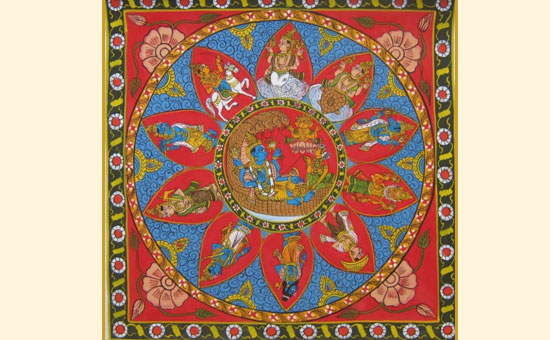 Scroll painting.
Scroll painting.
Formation
The
Nakashis are the artists of Telangana and
the scrolls constitute a key element of the social and cultural setting of
Telangana. These paintings were mostly confined to Cheriyal village, and hence
called Cheriyal scrolls. The scrolls earlier depicted the adventures and the
exploits of local folk heroes wherein each community had its popular heroes.
This
traditional art form is considered an inseparable part of the profession
comprising the story-telling and balladeer community called Kaki Padagollu. They have displayed these scrolls
which are also accompanied by music and dance. The scrolls would be flowing
like a film roll, which is usually nearly three feet in width and about 40 to
45 feet in length, based on the story.
Tradition
The
traditional scrolls are mostly of vertical format and illustrate the stories
through a series of horizontal panels. Here, there is a floral border in the
middle separating the two panels, and the linear narrative is shown, being held
with both hands or suspended from a tree. It is further rolled continually.
Compared
to the long scrolls in the past, now artists have adapted to paint smaller
versions of these scrolls that only depict any single episode or few characters
from the traditional stories. These can be framed easily and hung on walls of
modern homes.
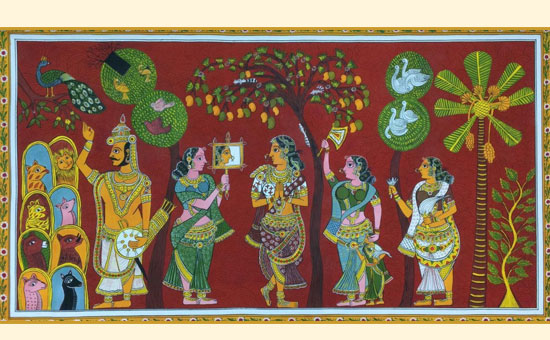 Smaller scroll.
Smaller scroll.
Process
The
canvas making is an elaborate procedure. It is made of Khadi cotton, starch,
white mud and a paste of tamarind seeds and gum water. After the canvas is
complete, the artists prepare the outline directly using a brush on the canvas.
These outlines are defined clearly and appear sharp which shows the quality as
well as the skill of the Cheriyal craftsman.
At
present, the Cheriyal painting work is being continued by some selected
families. There are only few artists remaining who still paint, making use of
this unique technique. One of the recent innovations is the painting of single
pictures instead of a continuous scroll for the purpose of wall decorations.
Themes
Cheriyal
Painting is easily recognized by certain unique characteristics.
These
are painted in vivid hues with mostly primary colors, showing a predominance of
red color in the background. These paintings are characterized by unbridled
imaginations of the local artisans.
In
this form of art, the iconography of major deities like Vishnu, Shiva, etc. too
carry a strong local idiom. The subjects of the scroll paintings are mostly
drawn from mythological, ancient literary and folk traditions. The major themes
are Krishna Leela, Mahabharata, Ramayana, Shiva Puranam, Markandey Puranam
along with the ballads and folk stories of Gauda, Madiga and other communities.
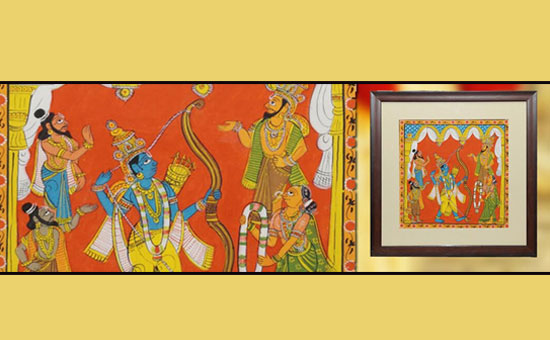
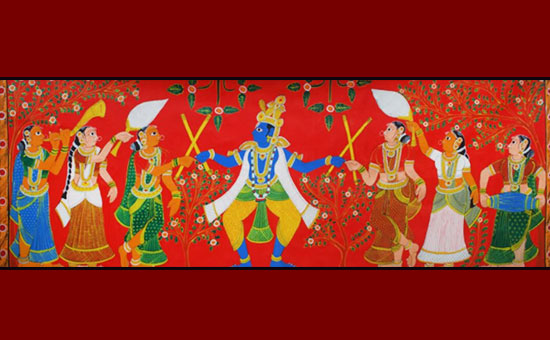
The
main narrative involves scenes from the common
rural life such as women performing kitchen chores, men working in
fields or experiencing merry, festival settings, etc. The costumes and settings
reflect the culture of Telangana.
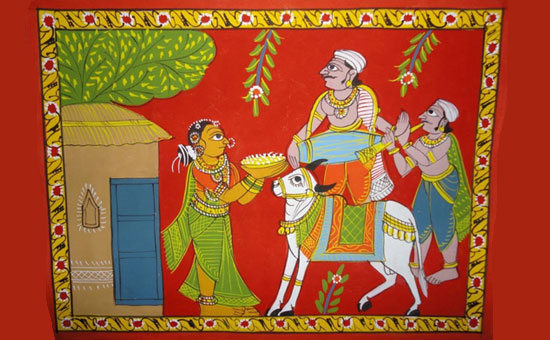 Rural life.
Rural life.
Cheriyal Dolls
In
the past, natural dyes were used. White was obtained from grounded sea shells,
black from lamp soot, yellow from turmeric, blue from indigo and the others
from various vegetable dyes and grounded stones.
Today
the natural dyes have largely been replaced by commercial organic water
colours, which are mixed with tree gums, before being applied on the scroll.
The
water coloured based Cheriyal Scrolls are said to last over 300 years provided
they don’t come in contact with water.
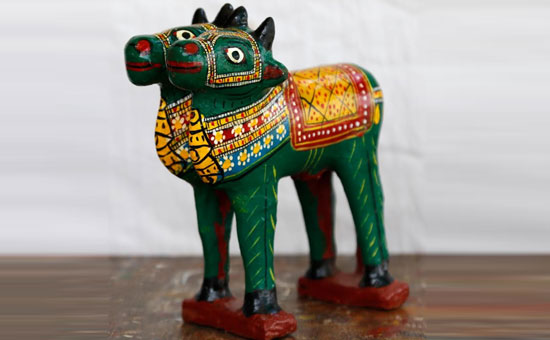 Decoration piece for modern day homes.
Decoration piece for modern day homes.
Cheriyal Mask
Apart
from the Scrolls, the Cheriyal artists also make dolls and masks. The smaller
masks are made of coconut shell while the larger ones are made out of sawdust
and tamarind seed paste.
The
Cheriyal dolls are made of a light wood called tella puniki and are smeared with saw dust and tamarind seed
paste. Like the scroll, both the dolls and masks have bright colours.
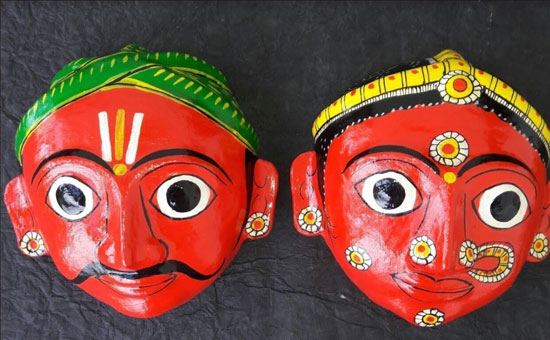 Face mask.
Face mask.
Cheriyal Key Ring
Cheriyal
paintings have made their way on gift boxes, pen and candle stands and even on
textiles, and also Cheriyal dolls have been transformed into decorative key
chains.
 Modern day usage.
Modern day usage.
Today
the Cheriyal Scroll painting art still flourishes but with the advent of other
forms of audio - visual entertainment and with the dwindling numbers of story
tellers and balladeers, the Cheriyal artist are forced to modify their art
form.
The
long elongated scrolls are made smaller to fit in the walls of modern day
drawing rooms and masks and dolls are customised into drawing room artifacts.
It
is a great wonder that the art of Cheriyal scroll painting is alive, despite of
the numerous challenges. The passion of the Cheriyal artists has helped to
preserve a valuable piece in India’s rich cultural mosaic.
Author is a Mumbai based artist.
The
purpose of this compilation is to document and promote. We have given credits
and reference links in this compilation. In case some are missed, it is not
with malafide intent.
To read all
articles by author